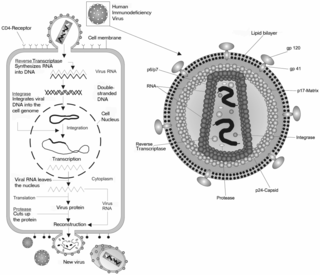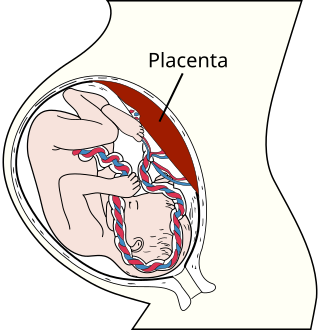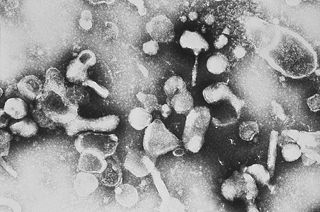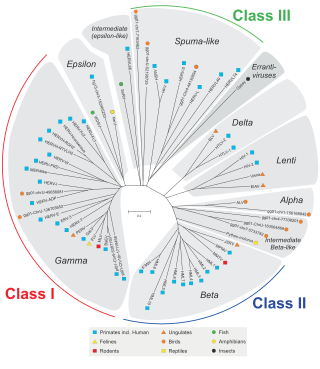
A retrovirus is a type of virus that inserts a DNA copy of its RNA genome into the DNA of a host cell that it invades, thus changing the genome of that cell. Once inside the host cell's cytoplasm, the virus uses its own reverse transcriptase enzyme to produce DNA from its RNA genome, the reverse of the usual pattern, thus retro (backwards). The new DNA is then incorporated into the host cell genome by an integrase enzyme, at which point the retroviral DNA is referred to as a provirus. The host cell then treats the viral DNA as part of its own genome, transcribing and translating the viral genes along with the cell's own genes, producing the proteins required to assemble new copies of the virus. Many retroviruses cause serious diseases in humans, other mammals, and birds.

The placenta is a temporary embryonic and later fetal organ that begins developing from the blastocyst shortly after implantation. It plays critical roles in facilitating nutrient, gas and waste exchange between the physically separate maternal and fetal circulations, and is an important endocrine organ, producing hormones that regulate both maternal and fetal physiology during pregnancy. The placenta connects to the fetus via the umbilical cord, and on the opposite aspect to the maternal uterus in a species-dependent manner. In humans, a thin layer of maternal decidual (endometrial) tissue comes away with the placenta when it is expelled from the uterus following birth. Placentas are a defining characteristic of placental mammals, but are also found in marsupials and some non-mammals with varying levels of development.

Gammaretrovirus is a genus in the Retroviridae family. Example species are the murine leukemia virus and the feline leukemia virus. They cause various sarcomas, leukemias and immune deficiencies in mammals, reptiles and birds.

Endogenous retroviruses (ERVs) are endogenous viral elements in the genome that closely resemble and can be derived from retroviruses. They are abundant in the genomes of jawed vertebrates, and they comprise up to 5–8% of the human genome.

Syncytiotrophoblast is the epithelial covering of the highly vascular embryonic placental villi, which invades the wall of the uterus to establish nutrient circulation between the embryo and the mother. It is a multi-nucleate, terminally differentiated syncytium, extending to 13 cm.

Jaagsiekte sheep retrovirus (JSRV) is a betaretrovirus which is the causative agent of a contagious lung cancer in sheep, called ovine pulmonary adenocarcinoma.
Simian foamy virus (SFV) is a species of the genus Spumavirus that belongs to the family of Retroviridae. It has been identified in a wide variety of primates, including prosimians, New World and Old World monkeys, as well as apes, and each species has been shown to harbor a unique (species-specific) strain of SFV, including African green monkeys, baboons, macaques, and chimpanzees. As it is related to the more well-known retrovirus human immunodeficiency virus (HIV), its discovery in primates has led to some speculation that HIV may have been spread to the human species in Africa through contact with blood from apes, monkeys, and other primates, most likely through bushmeat-hunting practices.
Env is a viral gene that encodes the protein forming the viral envelope. The expression of the env gene enables retroviruses to target and attach to specific cell types, and to infiltrate the target cell membrane.

HERV-R_7q21.2 provirus ancestral envelope (Env) polyprotein is a protein that in humans is encoded by the ERV3 gene.

Neutral amino acid transporter B(0) is a protein that in humans is encoded by the SLC1A5 gene.
HERV-K_19q12 provirus ancestral Pol protein is a protein that in humans is encoded by the ERVK6 gene.

Neutral amino acid transporter A is a protein that in humans is encoded by the SLC1A4 gene.

Early placenta insulin-like peptide is a protein that in humans is encoded by the INSL4 gene.

Syncytin-2 also known as endogenous retrovirus group FRD member 1 is a protein that in humans is encoded by the ERVFRD-1 gene. This protein plays a key role in the implantation of human embryos in the womb.
Mason-Pfizer monkey virus (M-PMV), formerly Simian retrovirus (SRV), is a species of retroviruses that usually infect and cause a fatal immune deficiency in Asian macaques. The ssRNA virus appears sporadically in mammary carcinoma of captive macaques at breeding facilities which expected as the natural host, but the prevalence of this virus in feral macaques remains unknown. M-PMV was transmitted naturally by virus-containing body fluids, via biting, scratching, grooming, and fighting. Cross contaminated instruments or equipment (fomite) can also spread this virus among animals.
An endogenous viral element (EVE) is a DNA sequence derived from a virus, and present within the germline of a non-viral organism. EVEs may be entire viral genomes (proviruses), or fragments of viral genomes. They arise when a viral DNA sequence becomes integrated into the genome of a germ cell that goes on to produce a viable organism. The newly established EVE can be inherited from one generation to the next as an allele in the host species, and may even reach fixation.
Human endogenous retrovirus K (HERV-K) or Human teratocarcinoma-derived virus (HDTV) is a family of human endogenous retroviruses associated with malignant tumors of the testes. Phylogenetically, the HERV-K group belongs to the ERV2 or Class II or Betaretrovirus-like supergroup. Over the past several years, it has been found that this group of ERVs play an important role in embryogenesis, but their expression is silenced in most cell types in healthy adults. The HERV-K family, and particularly its subgroup HML-2, is the youngest and most transcriptionally active group and hence, it is the best studied among other ERVs. Reactivation of it or anomalous expression of HML-2 in adult tissues has been associated with various types of cancer and with neurodegenerative diseases such as amytrophic lateral sclerosis (ALS). Endogenous retrovirus K (HERV-K) is related to mammary tumor virus in mice. It exists in the human and cercopithecoid genomes. Human genome contains hundreds of copies of HERV-K and many of them possess complete open reading frames (ORFs) that are transcribed and translated, especially in early embryogenesis and in malignancies. HERV-K is also found in apes and Old World monkeys. It is uncertain how long ago in primate evolution the full-length HERV-K proviruses which are in the human genome today were created.
Human Endogenous Retrovirus-W (HERV-W) is the coding for a protein that would normally be part of the envelope of one family of Human Endogenous Retro-Viruses, or HERVs.

Endogenous retrovirus group V member 2, envelope is a protein that in humans is encoded by the ERVV-2 gene.

Suppressyn (SUPYN) is a protein that in humans is encoded by the ERVH48-1 gene.













